Effective Public Relations: A Guide - Rotary International
Effective Public Relations: A Guide - Rotary International
Effective Public Relations: A Guide - Rotary International
Create successful ePaper yourself
Turn your PDF publications into a flip-book with our unique Google optimized e-Paper software.
conflict resolution. Include the names of<br />
people available for interviews, project<br />
information, and related story angles. Tailor<br />
the letter to the reporter and the medium<br />
as much as possible. Consider these tips:<br />
• Summarize your pitch in one page.<br />
• Explain why readers would be<br />
interested.<br />
• Detail the scope and significance of<br />
your project.<br />
• Provide a few interesting details.<br />
•<br />
•<br />
Offer alternate approaches to the<br />
story when possible.<br />
Describe possible photo opportunities.<br />
A picture is worth 1,000 words<br />
Photos increase interest in your story<br />
and give your release an extra edge.<br />
They should be an essential part of<br />
every PR plan. Consider these tips to<br />
help ensure a great photo:<br />
• Plan ahead. Determine the message<br />
you want to convey, and find a way to<br />
capture it in a photo.<br />
• Use a professional photographer or<br />
high-quality digital camera.<br />
• Take action shots. Images featuring<br />
hands-on activity create more interest<br />
than posed shots of people shaking<br />
hands and standing and facing the<br />
camera. A creative, active shot could<br />
be the deciding factor for an editor on<br />
whether to run a story.<br />
• Keep deadlines in mind. Send timely<br />
photos to the media well in advance<br />
of publishing deadlines. Make sure<br />
to include a caption with the correct<br />
spelling of names and a sentence<br />
explaining the event. Use the who,<br />
what, where, when, and why format to<br />
write captions.<br />
• Download current photos of RI officers<br />
at www.rotary.org.<br />
4<br />
Letter to the Editor<br />
The editorial page is one of the most-read<br />
sections of the newspaper, and your letter<br />
can reach many people. Keep these tips in<br />
mind when sending a letter to the editor:<br />
• Make one or two points and state<br />
them clearly, ideally in the first<br />
sentence.<br />
• Make your letter timely. If you aren’t<br />
addressing a specific article, editorial,<br />
or letter that ran recently, tie your<br />
comment to a recent event.<br />
• Familiarize yourself with the coverage<br />
and editorial position of the paper.<br />
Refute or support specific statements<br />
and address relevant facts that had<br />
been ignored, but avoid attacking the<br />
media in general or the newspaper in<br />
particular.<br />
• Check the letter specifications of the<br />
newspaper. Length and format requirements<br />
vary from paper to paper (about<br />
two short paragraphs are ideal). Remember<br />
to include your full name, title<br />
(if applicable), mailing address, e-mail<br />
address, and daytime phone number.<br />
Op-Ed<br />
An op-ed (positioned opposite the editorial<br />
page) is an opinion piece written by an<br />
individual who is not on the newspaper’s<br />
staff. Before writing an op-ed for your paper,<br />
learn what topics are of interest to your<br />
community. An op-ed should:<br />
• State a point of view<br />
• Provoke thought<br />
• Stimulate discussion<br />
Review the op-ed pieces in your paper<br />
before submitting your own. Like a letter<br />
to the editor, an op-ed should be brief and<br />
clearly stated.


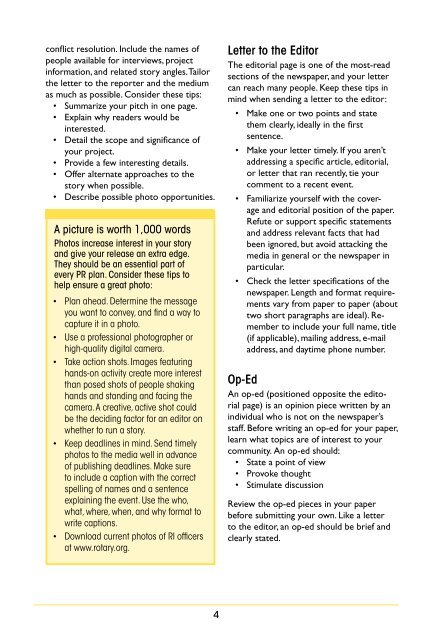
![La présidence du club [222-FR] - Rotary International](https://img.yumpu.com/25855726/1/190x245/la-presidence-du-club-222-fr-rotary-international.jpg?quality=85)
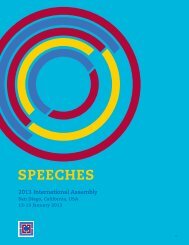
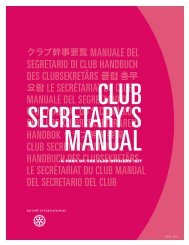


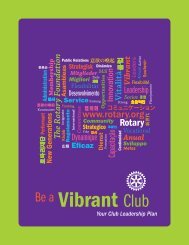
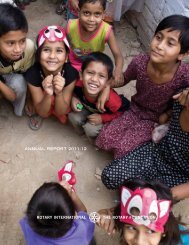

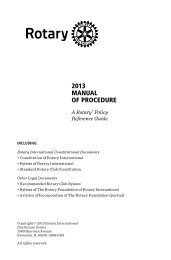

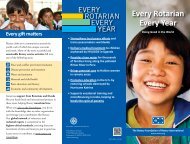
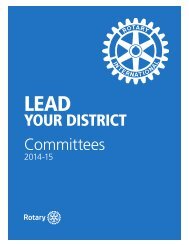

![La conférence de district [800-FR] - Rotary International](https://img.yumpu.com/25855636/1/190x245/la-conference-de-district-800-fr-rotary-international.jpg?quality=85)
